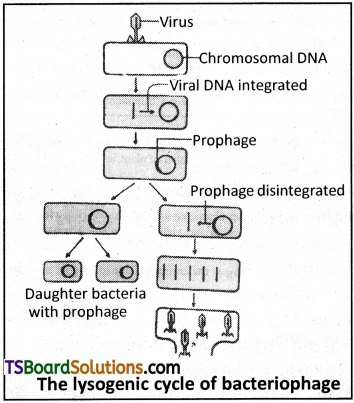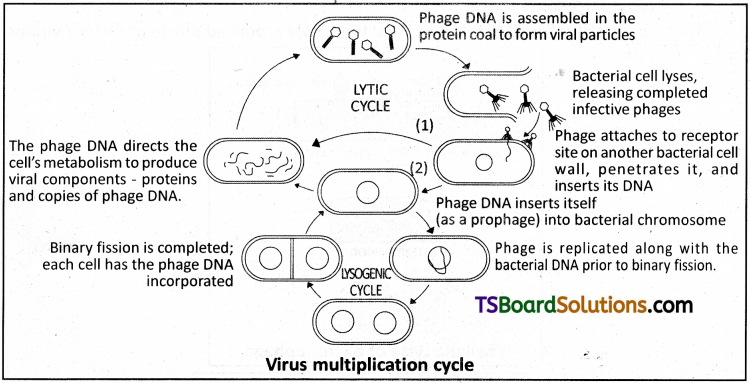Telangana TSBIE TS Inter 2nd Year Botany Study Material 8th Lesson Viruses Textbook Questions and Answers.
TS Inter 2nd Year Botany Study Material 8th Lesson Viruses
Very Short Answer Type Questions
Question 1.
Mention the living and non-living characters of viruses.
Answer:
Living characters:
- They contain nucleic acid.
- They maintain genetic continuity through multiplication and undergo mutations.
- The live as obligate intracellular parasites.
Non-living characters:
- They do not exhibit most of the life processes like growth, irritability.
- They are inert life less molecules.
- They are acellular.
- They do not have metabolic system.
Question 2.
What is the shape of T4 phage? What is its genetic material?
Answer:
- T4 phage is tadpole shaped with a large head and a tail.
- Genetic material is double stranded DNA.
Question 3.
What are virulent phages? Give an example.
Answer:
- The viruses that attack the bacterium E.coli, causes lysis of the cells are called virulent phages.
- Eg: T – even phages.
Question 4.
What is lysozyme and what is its function?
Answer:
- The viral enzyme which dissolves the plasma membrane of the host cell (bacterial cell) is called lysozyme.
- Lysozyme is synthesized within the cell and the bacterial cell wall breaks releasing the newly produced phage particles / virions.
Question 5.
Define ‘lysis’ and ‘burst size’ with reference to viruses and their effects on host cells.
Answer:
1. Lysis :
It is the final stage of lytic cycle, the host cell wall bursts during this phase and all the newly produced virions are released. This is known as lysis.
2. Burst size :
The number of newly synthesized phage particles released from a single host cell.
![]()
Question 6.
What is a prophage?
Answer:
- Prophase : It is the phage DNA that is incorporated into bacterial DNA and remains latent during lysogenic cycle.
- It is found in temperate phages and the prophase also undergoes replication.
Question 7.
What are temperate phages? Give one example.
Answer:
- Temperate phage: A bacteriophage whose DNA is incorporated into the host DNA to form prophase during lysogenic cycle.
- It does not cause immediate lysis and death of host, when they multiply Eg: Coliphase-λ.
Question 8.
Mention the differences between virulent phages and temperate phages.
Answer:
1. Virulent phages :
Bacteriophages that cause lysis of host at the end of replication (lytic cycle) Eg: T-even phages.
2. Temperate phages :
Bacteriophages, whose DNA is incorporated into host DNA to form prophases (lysogenic cycle) and do not cause immediate lysis of host. Eg: Coliphase-λ,.
Short Answer Type Questions
Question 1.
What is ICTV? How are viruses named?
Answer:
ICTV means International Committee on Taxonomy of Viruses. It regulates the norms of classification and nomenclature of viruses.
The ICTV scheme has only three hierarchial levels
– Family (including some sub – families)
– Genus
– Species
The family names end with the suffix ‘viridae’ while the genus names with ‘virus’ and the species names are common English expressions describing their nature.
Viruses are named after the disease they cause. Eg : Polio virus
Using the ICTV system, the virus that causes Acquired Immune Deficiency Syndrome (AIDS) in human beings is classified as :
Family : Retroviridae Genus : Lentivirus
Species : Human Immune Deficiency Virus (HIV).
![]()
Question 2.
Explain the chemical structure of viruses. [Mar. 2020]
Answer:
- All viruses consists of two basic components 1) core 2) capsid.
- Core is the nucleic acid that forms the genome. Capsid is the surrounding protein coat.
- Capsid gives shape and protection. It is made up of protein subunits called capsomeres. The no. of capsomeres is characteristic for each type of virus.
- Virus contains its genetic information in either double stranded (ds) DNA or single stranded (ss) DNA.
- Generally, viruses that infect plants have single stranded RNA and viruses that infect animals have double stranded DNA.
- Bacteriophages are usually ds DNA.
- Viral nucleic acid molecules are either circular or linear.
- Most viruses have a single nucleic acid molecule, but a few have more than one (Eg : HIV which has two identical molecules of RNA).
Question 3.
Write briefly about the symmetry of viruses.
Answer:
Helical virus are helical symmetry. They resemble long rods. Eg: RSbies virus and Tobacco mosaic virus.
Polyhedral symmetry :
Many plants and animals has polyhedral symmetry (many sides). Eg : Herpes simplex and polio viruses.
Binal symmetry :
Bacteriophage have both polyhedral symmetry in the head and helical symmetry in the tail sheath.
Spherical virus are enveloped virus. Eg : Influenza virus.
Question 4.
Explain the structure of TMV. [Mar. ’18 ’14; May ’17]
Answer:
- TMV was the first virus to be crystallized by Stanley.
- Fraenkel described the structure of TMV.
- Tobacco Mosaic Virus is a rod shaped virus. It is about 300 nm long and 18 nm in diameter, with a molecular weight of 39 x 106 Daltons.
- The capsid is made up of 2,130 subunits called capsomeres.
- Capsomeres are arranged in a helical manner around a central core of 4 nm.
- Each protein subunit is made up of a single polypeptide chain with 158 amino acids.
- Single stranded RNA is present inside the capsid and is also spirally coiled.
- RNA of TMV consists of 6,500 nucleotides.

Question 5.
Explain the structure of T – even bacteriophages. [Mar. 17, May’14]
Answer:

- The body of T-even bacteriophage can be distinguished into head and tail regions joined by a collar.
- The tail region includes a tail sheath, a base plate, pins and tail fibres which help the virus attach to host cell.
- The tail sheath aids in injecting viral DNA into the host cell.
Question 6.
Explain the lytic cycle with reference to certain viruses. [Mar. 2019]
Answer:
T – even phages that attack the bacterium E.coli cause lysis of the cells and are called virulent phages. They show lytic cycle. It involves 5 step process. They are 1. attachment 2. penetration 3. biosynthesis 4. maturation and 5. release.

1. Attachment:
- Contact of the virion to the surface of host bacterium is called attachment or adsorption.
- The phages use tail fibres for attachment to the complementary receptor sites on the bacterial cell wall.
2. Penetration :
- The injection of phage nucleic acid into the host cell is called penetration.
- The phage DNA is injected into the bacterium through the tail core like a hypodermal syringe.
- The capsid remains outside the bacterial cell and is referred to as ghost.
3. Biosynthesis :
- Once the phage DNA reaches the cytoplasm of the host cell, many copies of phage DNA, enzymes and capsid proteins are synthesized, using the cellular machinery of the host cell.
- Host cell do not contain any complete infective viruses.
4. Maturation :
- In this process bacteriophage DNA and capsids are assembled into complete virions.
- This period of time between the infection by a virus and the appearance of the mature virus within the cell is called the eclipse period.
5. Release :
- The final stage of viral multiplication is the lysis phase of the host cell and the release of virions from the host cell.
- The plasma membrane of the host cell gets dissolved or lysed due to viral enzyme called lysozyme.
- The bacterial cell wall breaks releasing the newly produced phage particles /virions.
![]()
Question 7.
Explain how temperate phages play a role in transduction.
Answer:

- In lysogenic cycle, some bacteriophages such as X (Lambda) phages do not cause lysis
during multiplication. - Instead, the phage DNA upon penetration into the E.coli gets integrated in to the circular bacterial DNA, becomes part of it and remains latent (inactive). Such phages are called temperate phages. This inserted phage DNA is now called prophage.
- Every time the bacterial genetic material replicates, the prophage also gets replication. The prophage remains latent in the progeny cells.
- However, rarely prophage gets disintegrated when they are exposed to UV light or some chemicals and enter into lytic cycle.
- Thus temperate phase plays a role of transduction by the transfer of genetic material from one bacterium to another through bacteriophage.
Question 8.
Mention the differences between lytic and lysogenic cycles.
Answer:
| Lytic cycle | Lysogenic cycle |
| 1. At the end of lytic cycle, bacterial cell undergoes lysis. | 1. Bacterial cell does not undergo immediate lysis. |
| 2. The entry of viral DNA brings about the degradation of bacterial DNA. | 2. Bacterial DNA is not destroyed and viral DNA gets incorporated. |
| 3. Prophages are not formed and the virulent phages do not allow bacteria to survive. | 3. Prophages persists in close relationship for long period even when bacterial cell undergoes many division cycles. |
| 4. The viruses are called virulent phages. Eg : T – even phages | 4. The viruses are called temperate phages. Eg : Coliphage – λ |
Long Answer Type Questions
Question 1.
Write about the discovery and structural organization of viruses.
Answer:
- Viruses have been causing diseases in humans, animals and plants from the ancient time.
- ‘Germ theory of disease’ was put forth by Louis Pasteur but the agent responsible for the diseases are not known.
- In 1892 for the first time, the Russian pathologist Dmitri Iwanowski, while studying tobacco mosaic disease, filtered the “sap of diseased tobacco leaf” through filter which was designed to retain bacteria. However the infectious agent passed through the pores of the filter. After injecting the filtered sap into the healthy plant, he found the development of symptoms of mosaic disease in it. Unable to see any microorganism in a sap, he reported that the filterable agent was responsible for the disease.
- Martinus Beijerinck repeated Iwanowski’s experiments and concluded that the disease causing agent was a contagious living fluid (contagium vivum fluidum).
- W.M. Stanley (1935) purified the sap and announced that the virus causing mosaic disease in tobacco could be crystallized. It was named as Tobacco Mosaic Virus (TMV).
- Fraenkel Conrat (1956) confirmed that the genetic material of the TMV is RNA.
![]()
Question 2.
Describe the process of multiplication of viruses.
Answer:
The process of multiplication of viruses is done by two alternative mechanisms.
a) Lytic cycle b) Lysogenic cycle
a) Lytic cycle :
T – even phages that attack the bacterium E.coli cause lysis of the cells and are called virulent phages. They show lytic cycle. It involves 5 step process. They are 1. attachment 2. penetration 3. biosynthesis 4. maturation and 5. release.
1. Attachment:
- Contact of the virion to the surface of host bacterium is called attachment or adsorption.
- The phages use tail fibres for attachment to the complementary receptor sites on the bacterial cell wall.
2. Penetration :
- The injection of phage nucleic acid into the host cell is called penetration.
- The phage DNA is injected into the bacterium through the tail core like a hypodermal syringe.
- The capsid remains outside the bacterial cell and is referred to as ghost.
3. Biosynthesis :
- Once the phage DNA reaches the cytoplasm of the host cell, many copies of phage DNA, enzymes and capsid proteins are synthesized, using the cellular machinery of the host cell.
- Host cell do not contain any complete infective viruses.
4. Maturation :
- In this process bacteriophage DNA and capsids are assembled into complete virions.
- This period of time between the infection by a virus and the appearance of the mature virus within the cell is called the eclipse period.
5. Release :
- The final stage of viral multiplication is the lysis phase of the host cell and the release of virions from the host cell.
- The plasma membrane of the host cell gets dissolved or lysed due to the viral enzyme called lysozyme.
- The bacterial cell wall breaks releasing the newly produced phage particles / virions.

b) Lysogenic cycle :

- In lysogenic cycle, some bacteriophages such as X (Lambda) phages do not cause lysis during multiplication.
- Instead the phage DNA upon penetration into the E.coli gets integrated in to the circular bacterial DNA, becomes part of it and remains latent (inactive). Such phages are called temperate phages. This inserted phage DNA is now called prophage.
- Every time the bacterial genetic material replicates, the prophase also gets replication. The prophage remains latent in the progeny cells.
- However, rarely prophage gets disintegrated when they are exposed to UV light or some chemicals and enter into lytic cycle.
- Thus temperate phase plays a role of transduction by the transfer of genetic material from one bacterium to another through bacteriophage.

Intext Question Answers
Question 1.
When discussing the multiplication of viruses, Virologists prefer to call the process as replication, rather than reproduction. Why?
Answer:
- Viral reproduction requires a living cell to takes place. Virus do not go through mitosis
or cytogenesis nor do they have any mitotic machinery to produce new virus. - Virus cannot reproduce without a host cell or infect whereas a reproductive cell are show independent replication.
- The cell infected by virus die immediately (lytic cycle) or after sometime (lysogenic cycle). Hence virologist prefer to call the multiplication of viruses as replication rather than reproduction.
![]()
Question 2.
In dealing with public health, the approach to deal with bacterial diseases is treatment. Can you guess the nature of the general public health approach to viral diseases ? What example do you cite to support your answer?
Answer:
The most effective medical approaches to viral diseases are vaccinations to provide immunity to infection and antiviral therapy to overcome drug resistance. Antibiotics have no effect on viruses. Ex : AIDS, Viral hepatitis and many more.